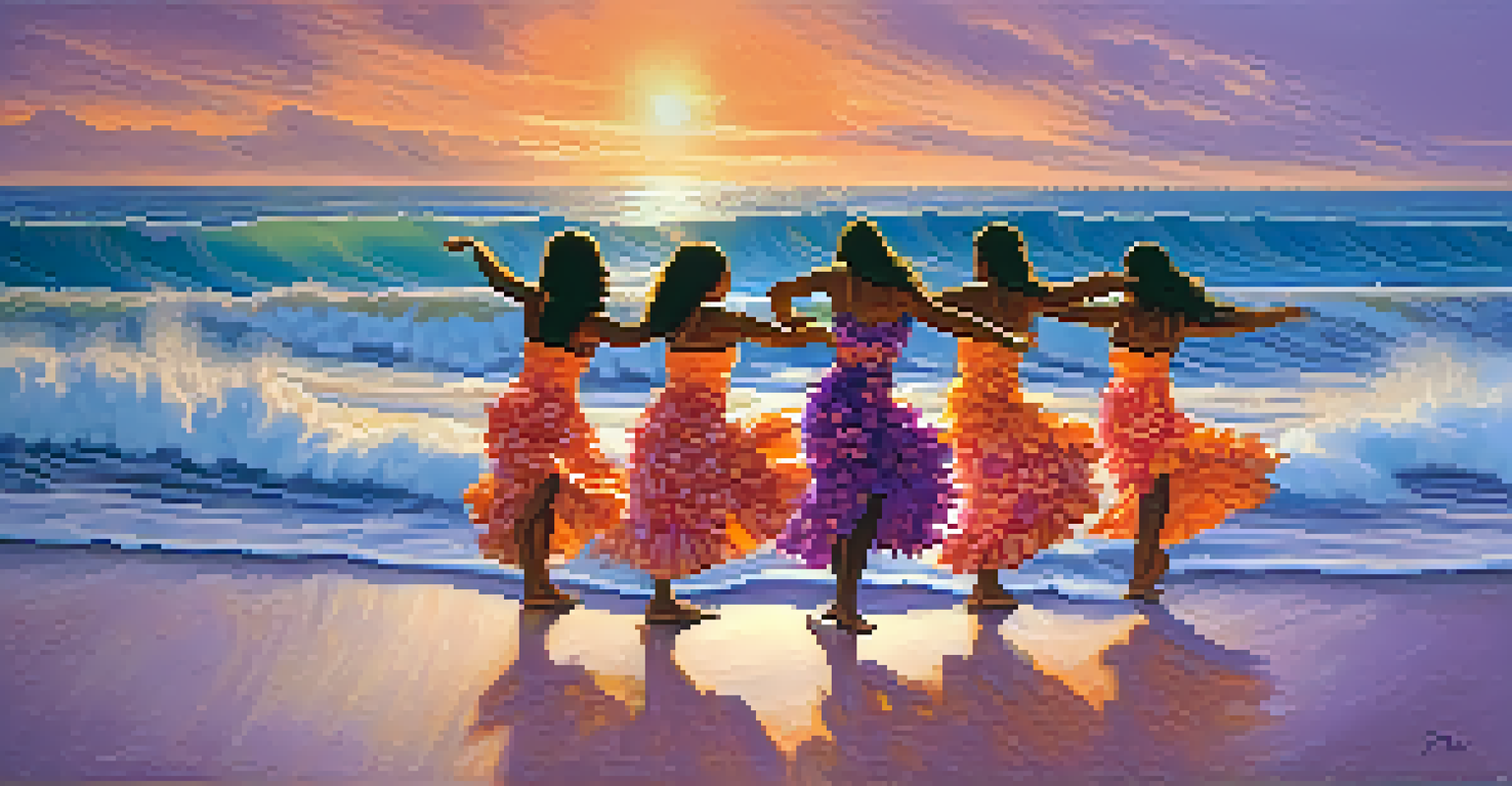The Interplay of Music and Dance in Ritualistic Celebrations

Understanding Ritualistic Celebrations Around the World
Ritualistic celebrations are woven into the fabric of cultures globally, serving as a way to connect individuals with their heritage and community. These gatherings often mark significant life events, seasonal changes, or religious observances, providing a structured way for people to express joy, grief, or gratitude. Through these celebrations, communities reinforce shared values and traditions, creating a sense of belonging.
Dancing is creating a sculpture that is visible only for a moment.
At the heart of many of these celebrations lie music and dance, which act as universal languages transcending cultural barriers. They bring energy and rhythm to rituals, creating an atmosphere that invites participation and emotional engagement. Each dance step or musical note has meaning, often reflecting the history and beliefs of the community.
For example, in many African cultures, dance is not just art but a vital aspect of storytelling and spirituality. As participants move to the rhythm of drums, they connect with their ancestors, celebrating life’s cycles and honoring their lineage. This interplay between music and dance creates a powerful experience that resonates deeply with participants and observers alike.
The Role of Music in Ritualistic Celebrations
Music serves as a profound tool in ritualistic celebrations, often setting the emotional tone and guiding the flow of activities. From the soft melodies of a wedding ceremony to the vibrant beats of a festival, music evokes feelings that words alone cannot express. It acts as a catalyst for connection, drawing people into the moment and encouraging participation.

Different cultures utilize various musical instruments, each contributing to the unique soundscape of their rituals. For instance, the didgeridoo in Australian Aboriginal ceremonies or the sitar in Indian classical music provides a distinct auditory experience that enhances the celebration's significance. These sounds are not merely background; they are integral to the storytelling and spiritual expression.
Music and Dance Unite Cultures
Ritualistic celebrations use music and dance as universal languages that connect individuals to their heritage and community.
Moreover, the use of music in rituals often involves specific songs that hold historical or cultural importance. These songs might recount ancient tales, celebrate gods or nature, or commemorate significant events, allowing communities to pass down their history through generations. This continuity nurtures a sense of identity and pride among participants.
The Importance of Dance in Ritualistic Celebrations
Dance brings a dynamic element to ritualistic celebrations, offering participants a way to express their emotions physically. Movement can convey joy, sorrow, gratitude, or reverence, allowing individuals to connect with the spiritual and communal aspects of the ritual. In many cultures, dance is considered a form of prayer or meditation, facilitating a deeper connection to the divine.
Music can change the world because it can change people.
Ritual dances often come with specific steps, formations, and meanings, making them an important aspect of cultural preservation. For example, the hula dance in Hawaiian culture not only entertains but also narrates stories of creation, love, and nature, keeping ancestral knowledge alive. These movements are a visual representation of the culture's values and beliefs.
Additionally, dance fosters a sense of unity among participants, as they move together in rhythm and harmony. This collective experience can strengthen community bonds, creating shared memories that linger long after the celebration has ended. The act of dancing together transforms a gathering into a lively celebration of life itself.
Cultural Variations in Music and Dance Practices
While the interplay of music and dance is a common thread in ritualistic celebrations, the specifics can vary widely across cultures. For instance, a traditional wedding celebration in India may feature intricate dance forms like Bharatanatyam, accompanied by classical music, whereas a Native American powwow may involve energetic group dances and drumming. Each style reflects the community's cultural identity, history, and values.
The variations in music and dance practices are often influenced by geography, history, and social structures. For example, the incorporation of modern music styles into traditional dances can be seen in many cultures, showcasing adaptability while still honoring their roots. This evolution allows ritualistic celebrations to remain relevant in contemporary society.
Psychological Benefits of Rituals
Engaging in music and dance during rituals fosters emotional release, social bonds, and a sense of belonging among participants.
Moreover, cultural exchanges and globalization have led to the blending of music and dance styles, creating new forms of expression. Festivals today might feature a fusion of traditional dances with contemporary music, reflecting a dynamic interplay between the old and the new. This creates a rich tapestry of celebration that resonates with a diverse audience.
The Psychological Impact of Music and Dance in Rituals
The combination of music and dance in ritualistic celebrations has a profound psychological impact on participants. Engaging in these activities can lead to feelings of joy, release, and even catharsis, providing a break from daily stressors. The rhythmic movements and melodies stimulate endorphin release, promoting a sense of well-being and connection.
Additionally, participating in communal dance and music can strengthen social bonds, creating a shared experience that fosters belonging. This collective participation can be especially powerful during significant life events, such as weddings or funerals, where emotions run high. The shared act of celebrating or mourning together can facilitate healing and support.
Furthermore, the immersive nature of music and dance can lead to altered states of consciousness, allowing individuals to transcend their everyday experiences. This spiritual aspect often enhances the significance of the ritual, as participants may feel a deeper connection to the divine or the universe. Such experiences can lead to personal growth and a renewed sense of purpose.
Ritualistic Celebrations as a Means of Cultural Transmission
Ritualistic celebrations serve as powerful vehicles for cultural transmission, where music and dance play crucial roles. Through these celebrations, cultural values, beliefs, and practices are passed down from generation to generation. The rhythms and movements not only entertain but also educate, ensuring that the community's heritage remains alive and vibrant.
For instance, children often learn the significance of their culture by participating in these rituals from a young age. As they witness and engage in the dances and songs, they absorb the stories and teachings embedded within them. This hands-on experience fosters a profound understanding of their identity and belonging within the community.
Cultural Transmission Through Rituals
Ritualistic celebrations serve as vital platforms for passing down cultural values and practices, ensuring the continuity of community heritage.
Moreover, in today's global society, these rituals can also promote cross-cultural understanding. As communities share their music and dance traditions with others, they invite dialogue and appreciation for diversity. This exchange enriches everyone's experience, allowing for a broader understanding of humanity and the connections that bind us all.
Conclusion: The Enduring Legacy of Music and Dance in Rituals
The interplay of music and dance in ritualistic celebrations underscores the rich tapestry of human culture. These elements not only enhance the emotional and spiritual dimensions of rituals but also serve as a means of cultural preservation and transmission. As we participate in these celebrations, we connect with our heritage and the larger human experience.
In a world that is constantly changing, the rituals that incorporate music and dance provide continuity and stability, reminding us of our shared history and values. They invite us to come together, to celebrate life’s milestones, and to honor the cycles of existence. This enduring legacy ensures that the essence of our cultures remains vibrant and alive.

As we move forward, let us cherish and embrace the music and dance that enrich our rituals, recognizing their power to unite us and deepen our understanding of ourselves and each other. In this way, we not only celebrate our past but also pave the way for future generations to experience the beauty of cultural expression.